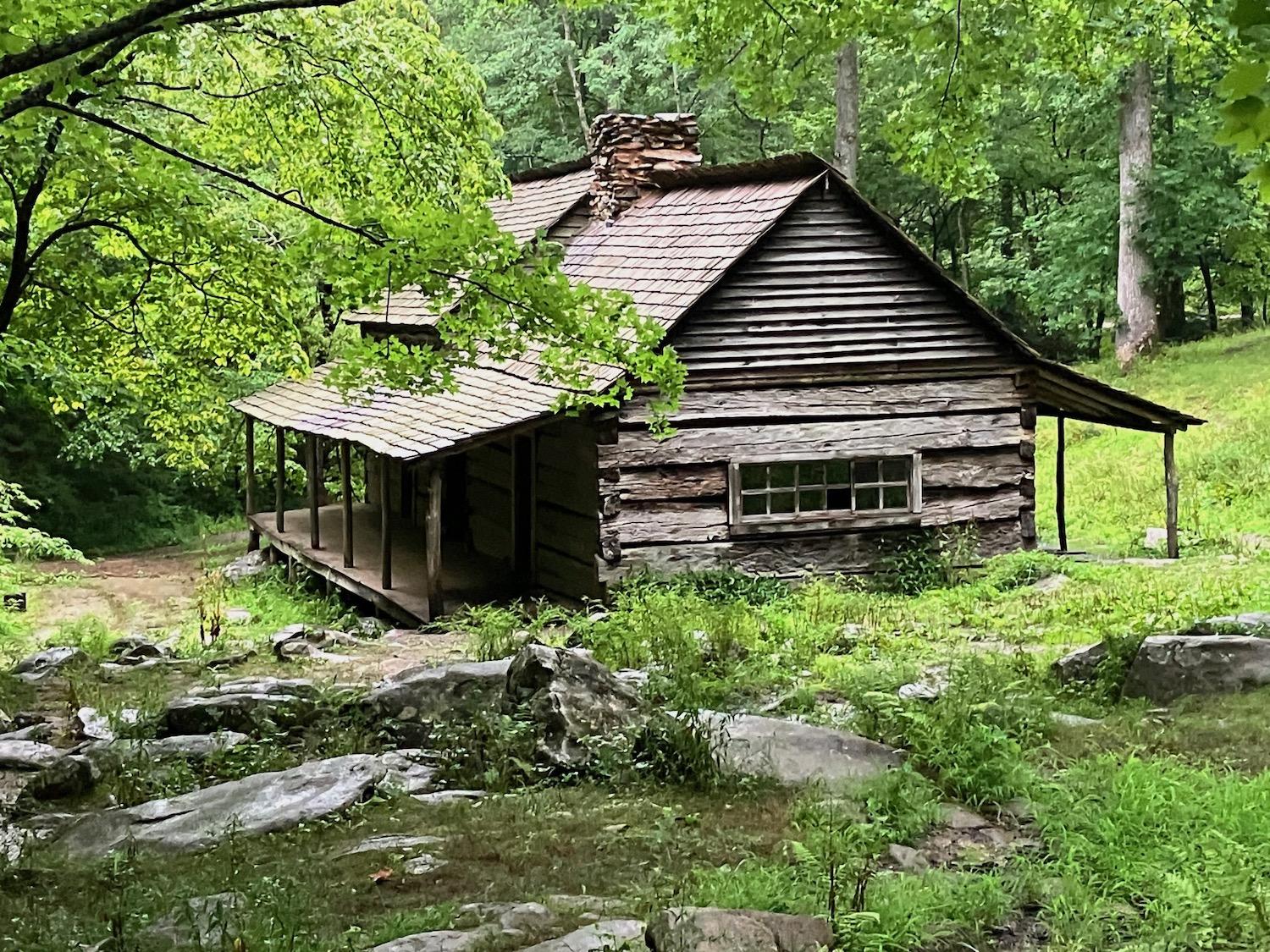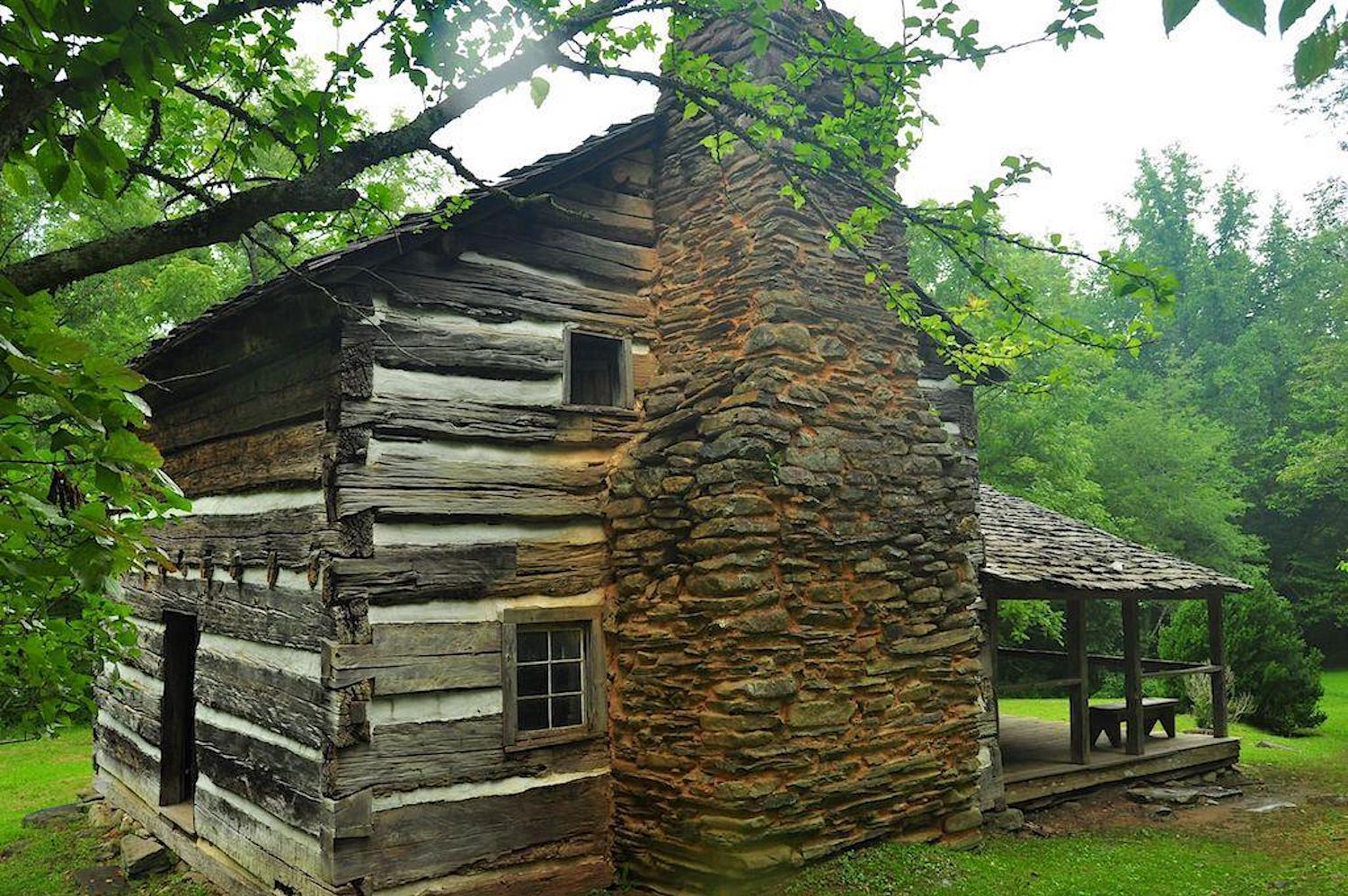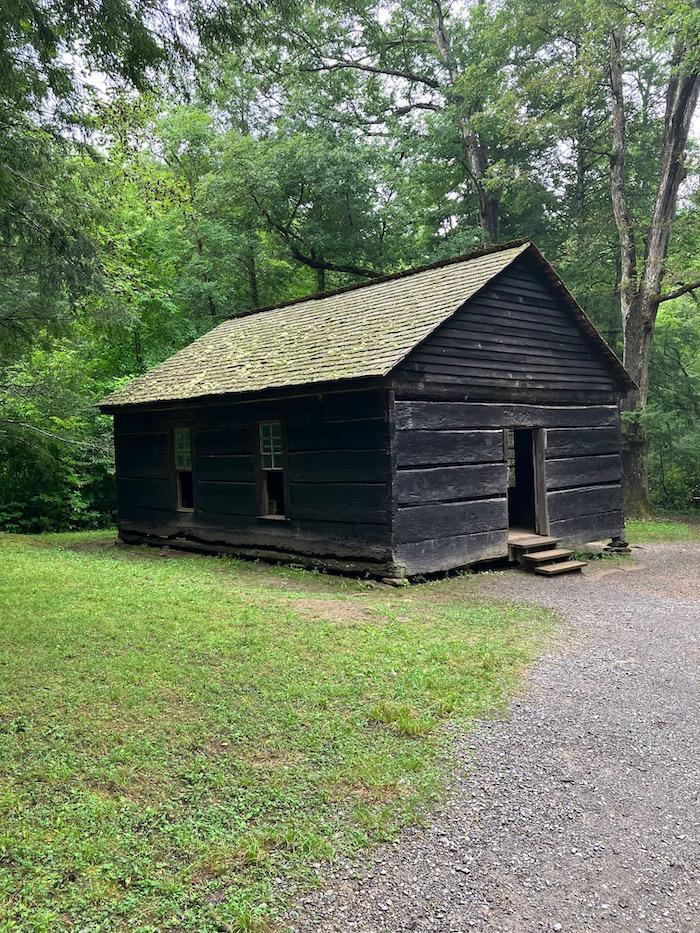
Windows To The Past At Great Smoky Mountains National Park
By Kim Kobersmith
GREAT SMOKY MOUNTAINS NATIONAL PARK — To reach the Walker Sisters Cabin, built around 1855, my traveling partner and I drove down a short gravel road to a small parking lot. We travelled the last mile on foot, up the old valley road. The trail followed a singing brook and leisurely climbed through a lush forest festooned with wildflowers. The last turn wended through an opening in the canopy and emerged into the center of the former 122-acre homestead.
There was a spring house, where the clear, cold water kept butter and cheese from spoiling, and a corn crib, where the crucial grain was stored through the winter. The three-room log home felt welcoming and spacious. The main room was anchored on one side with a large stone fireplace and windows poured light into the 450-square-foot space. One wall holds remnants of the newspaper and magazine pages they papered the walls with, a common practice to lighten and brighten log homes. A ladder gave access to the second floor, a storage loft that ran the same size as the floor below.
A separate kitchen sequestered cooking heat in the steamy summer months and gave rise to their celebrated and abundant meals. As we sat on the broad porch, listening to the quiet sounds of the forest and breathing in the fresh mountain air, I could just imagine spending firefly-lit evenings here shelling peas and snapping beans after a full day’s work.
On a short visit, it is hard not to romanticize life in this mountain enclave.
Six Walker sisters, born in the late 1800s, lived out their entire lives here. Louisa, who passed in 1964 at the age of 82, was one of the last remaining mountain residents within Great Smoky Mountains National Park. Their lives were lived close to the land, nourished by garden and forest. They possessed the skills necessary to thrive: hunting, gardening, sewing, weaving, cooking, butchering, canning, spinning. They raised sheep, made their own cloth, and had an orchard with 20 varieties of apples.
Much of their lifestyle was rooted in earlier times, but they were not stuck in the past. One or the other of them would periodically work off the farm for a couple of months, crunching numbers or knitting hosiery in a Knoxville factory. At least one of them had a penchant for store bought hats.

The Walker Sisters cabin, before recent renovations/NPS file
A Time Of Transition
The early 20th century was a major transition in the Smokies, a time when mountain homesteads were giving way to logging, industry, tourism, and eventually, the national park. The nearly 100 houses, barns, gristmills, churches, and corncribs preserved here provide a window into life before and during that transition. Great Smoky Mountains National Park stewards the largest collection of historic log buildings in the United States as cultural resources that tell stories of resilience, of abundance, of thriving business, and of nurturing community. And while time and weather threaten their futures, park supporters have banded together to preserve these places that serve as cultural touchstones.

The Greenbrier School/Kim Kobersmith
“People have carved a life in these mountains for more than 10,000 years, and you can’t separate the mountains from the people,” said Dana Soehn, CEO of Friends of the Smokies, one of the nonprofit groups that works with the National Park Service to preserve and protect the park and its resources. “We protect the rich stories of some of the early Appalachian Mountain settlers, the places where they weathered storms and celebrated holidays. These treasures and their way of life tell a part of our American story.”
Back at the parking lot sits another historic structure, the one-room Little Greenbrier School. The broad exterior boards, cut from massive tulip poplar trees, have worn dark and smooth with age. It provided the only formal education the Walker sisters had. The cabin doubled as the community church, and a fenced cemetery clings to the steep hill. The entire community banded together, contributing what they had, to construct it in 1882. Sister Louisa Walker was a poet and wrote about the efforts to build the school:
My father and other men met
In this valley years ago
To build a house for church and school
Where their children could go.
They cut logs in the forest
Though they had no saw mills
The logs were drawn by oxen
Near the foot of the hill
There they were hewn
And notched with care
To build the school house
That now stands there.
A Fuller History
While the Roaring Fork Motor Nature Trail is one of the more popular destinations in the park, we found relative solitude there after an early dinner. Parking scattered along the one-way drive gives close access to a number of individual homesteads. Here, farms are rocky, mountainous, rugged. But while these homesteads have the appearance of a hard scrabble existence, they provided a comfortable livelihood.
The “Bud” Ogle Farm, the first on the drive, was literally hewn from the forest. The interpretive sign states the property was called “Junglebrook” because of the thicket of native rhododendron and magnolias along the creekbanks. Occupied from 1883 to 1925, the Ogle homestead (top photo) consisted of a generous two-room cabin, a large barn and corn crib, a creek-side mill, and a wooden flume plumbing system that provided running water to the home. The outside walls of the generous two-room cabin are a warm gray, reflecting their age and decades of deflecting rain and snow . While a cornfield might seem out of place in this rocky terrain, the adaptable grain was actually a major crop for these mountain farmers.
But these rugged homesteads only tell part of the story of what life was like for former Smokies residents in the early 20th century. Cataloochee Valley, in the park's northeastern corner, offers another perspective. While isolated, this area was one of the more prosperous settlements, with 1,200 residents in 1910. The preserved wood frame structures here reflect that prosperity; they are more refined and include a three-story home and two churches.
Valley farms like those in Cataloochee were more fertile and might cover several hundred acres. The Cataloochee economy centered around apple orchards, and the Messer family had a large one. Their apple house stored and processed the more than 2,500 bushels they harvested each year. Their fruit was shipped via rail and road as far as Knoxville, Tennessee, and Charlotte, North Carolina.
As former Cataloochee Valley resident Charlie Palmer said, “…it was more like livin’ in the Garden of Eden than anything else I can think of.”
The Birth Of A Park
In the North Carolina section of the park, Ocanaluftee Visitor Center and the adjacent Mountain Farm Museum interpret some of the cultural history of the mountains. Exhibits explain that the seeming abundance of structures are just a sampling of those here in 1934 when the area was chartered as a national park. Park status displaced more than 1,200 families and led to the destruction of more than 2,500 churches, homes, and schools.
Of those former residents, some gladly left their mountain land; others still miss their ancestral homes. A handful, like the Walker sisters, negotiated lifetime leases so they could live out their lives in the new park. Thanks to their sacrifices, this slice of southern Appalachia and its natural and cultural history have been preserved for everyone.
But there was another powerful force at work lending credence to conserving this wild, habited country. Ranger Brad Free specializes in the history of another collection of historic homes, called Daisy Town, and gives weekly tours to tell its story. Nestled in the forest at the end of the Elkmont road, Daisy Town is a quintessential summer escape: rustic cabin architecture, arranged in a cozy neighborhood, alongside a rushing stream. Homes had running water and full bathrooms. The log Appalachian Clubhouse hosted grand balls in its heyday, and never-completed plans included a nine-hole golf course.

Rob Sanders with the Forever Places preservation crew points out some of their repairs to the John Ownby Cabin/Kim Kobersmith
These were the craftsman-style summer homes of wealthy city dwellers. Thanks to a growing automobile culture and a back-to-nature movement inspired by President Theodore Roosevelt, more than 80 cabins were constructed here in the early 1900s under the towering birch, hickory, and oak canopy. Tourism was emerging as an important industry in the Smokies and this was its epicenter.
The original owners of these retreat homes were instrumental in creating Great Smoky Mountains National Park. They were intent on sharing the natural beauty and rich culture of the Appalachian region with an international audience and creating economic opportunity for local residents. Besides promoting the area as a destination, they also gave some of the first significant donations towards purchasing the land for the park.
Their vision and advocacy have made a difference in the lives of local residents. According to a 2021 National Park Service report, park visitors spent over a billion dollars at local communities in 2020 and supported 14,000 jobs.
Forever Places
The John Ownby Cabin is just a short walk from the Sugarland Visitor Center but far from the bustling crowd. During my visit in a steady rain, a small crew was working on restoring the structure. Rob Sanders, an historical restoration specialist, was using a draw knife to prepare a frame piece for the fireplace arch. He explained they take great care to retain as much of the original structure as possible and utilize historic techniques in their repairs. When another cabin chimney needed new mortar during restoration, the mason meticulously numbered each rock to ensure the new one would be as close to the original as possible.
This one-room home has stood here since 1860 and age was taking its toll. The team put on a new roof and floor and replaced compromised logs on the exterior. Just as the original builders used raw materials from the bounty of the mountains, so do the restorers. The wood for the Ownby cabin repairs (with the exception of cedar roof shakes, chosen for longevity) came from a downed pine tree in the park. The crew cut the tree into boards using their portable saw mill.
Much of the current preservation work is thanks to a new endowment by Friends of the Smokies called “Forever Places.” They have carefully restored much of Daisy Town and this June, the Walker Sisters Cabin. Soehn explained, “It can be incredibly challenging to care for 200-year-old structures in a temperate rain forest, especially with declining park budgets in the last decade. The Friends have filled that gap.”
The endowment provides crucial funding for a crew of full-time skilled craftsmen to restore and maintain these structures. Established in 2020, the “Forever Places” fund now totals $4.5 million of the hoped-for $9 million and subsidizes two dedicated staff, including Sanders, with help from seasonal workers.
Keeping the Past Alive
When we first arrived at the Walker Sisters Cabin, a group of five children was lined up on one of the benches, enjoying a snack. One of their dads walked over and asked them if they would like to live in a place like this. They all shouted, “Yes!” But as he pointed out some of the realities of life here — no flushing toilet, no television — they were decidedly less enthusiastic.
I also overheard a family talking after their visit to the Mountain Farm Museum. The girl remarked, after reaching into the cabin to touch it, how hard the bed was. The mom thought a minute, then replied, “Yes, it’s a privilege to have the kind of bed you have.”
It is important to keep alive stories of self-sufficiency, of hard work, and of a simpler time, the stories that are told through the historical buildings at Great Smoky Mountains National Park.
“I find it encouraging that parents want to expose their kids to different lifestyles,” said Free. “Everybody can find a little piece of themselves, of their pasts, here. I hope we plant a seed to encourage people to preserve what they’ve got.”
The park will offer special living history events this fall at Daisy Town, the Mountain Farm Museum, and Cades Cove.

Comments
My grandparents were born and raised in the Smoky mountains. When the Federal government took their lands out from under them, they were lost. They moved to Gastonia and tried to make a living. They both died young, unhappy and felt unwanted. So sad.